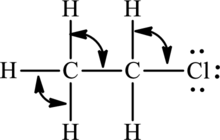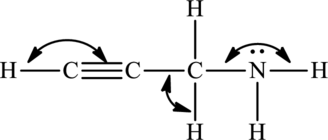
PRIN.OF GENERAL,ORGANIC+BIOLOG.CHEM.
2nd Edition
ISBN: 9781266811852
Author: SMITH
Publisher: MCG
expand_more
expand_more
format_list_bulleted
Concept explainers
Question
Chapter 3, Problem 3.94AP
(a)
Interpretation Introduction
Interpretation:
The bond angles around the indicated atoms in the compound have to be predicted.
The given compound is,

(b)
Interpretation Introduction
Interpretation:
The bond angles around the indicated atoms in the compound have to be predicted.
The given compound is,

Expert Solution & Answer
Want to see the full answer?
Check out a sample textbook solution
Students have asked these similar questions
For the titration of a divalent metal ion (M2+) with EDTA, the stoichiometry of the reaction is typically:
1:1 (one mole of EDTA per mole of metal ion)
2:1 (two moles of EDTA per mole of metal ion)
1:2 (one mole of EDTA per two moles of metal ion)
None of the above
Please help me solve this reaction.
Indicate the products obtained by mixing 2,2-dimethylpropanal with acetaldehyde and sodium ethoxide in ethanol.
Chapter 3 Solutions
PRIN.OF GENERAL,ORGANIC+BIOLOG.CHEM.
Ch. 3.1 - Predict whether the bonds in the following species...Ch. 3.2 - Write the ion symbol for an atom with the given...Ch. 3.2 - Prob. 3.4PCh. 3.2 - Prob. 3.5PCh. 3.2 - How many electrons and protons are contained in...Ch. 3.2 - Prob. 3.7PCh. 3.3 - Write the formula for the ionic compound formed...Ch. 3.3 - Prob. 3.9PCh. 3.4 - Prob. 3.10PCh. 3.4 - Give the symbol for each ion. a. stannous b....
Ch. 3.4 - Name each ionic compound. a. NaF b. MgO c. SrBr2...Ch. 3.4 - Name each ionic compound. a. CrCl3 b. PbS c. SnF4...Ch. 3.4 - Prob. 3.14PCh. 3.5 - List four physical properties of ionic compounds.Ch. 3.6 - Write the formula for the compound formed when K+...Ch. 3.6 - Prob. 3.17PCh. 3.6 - Name each compound. a. Na2CO3 b. Ca(OH)2 c....Ch. 3.6 - Prob. 3.19PCh. 3.7 - Use electron-dot symbols to show how a hydrogen...Ch. 3.7 - Prob. 3.21PCh. 3.8 - Draw a Lewis structure for each covalent molecule....Ch. 3.8 - Prob. 3.23PCh. 3.8 - Prob. 3.24PCh. 3.9 - Prob. 3.25PCh. 3.9 - Prob. 3.26PCh. 3.10 - Prob. 3.27PCh. 3.11 - Prob. 3.28PCh. 3.11 - Prob. 3.29PCh. 3.11 - Show the direction of the dipole in each bond....Ch. 3.12 - Prob. 3.31PCh. 3.12 - Prob. 3.32PCh. 3 - Which formulas represent ionic compounds and which...Ch. 3 - Which pairs of elements are likely to form ionic...Ch. 3 - Prob. 3.35UKCCh. 3 - Prob. 3.36UKCCh. 3 - Prob. 3.37UKCCh. 3 - Prob. 3.38UKCCh. 3 - Prob. 3.39UKCCh. 3 - Prob. 3.40UKCCh. 3 - Prob. 3.41UKCCh. 3 - Prob. 3.42UKCCh. 3 - Prob. 3.43UKCCh. 3 - Prob. 3.44UKCCh. 3 - Prob. 3.45UKCCh. 3 - Prob. 3.46UKCCh. 3 - (a) Translate each ball-and-stick model to a Lewis...Ch. 3 - Prob. 3.48UKCCh. 3 - Prob. 3.49APCh. 3 - How many protons and electrons are present in each...Ch. 3 - Prob. 3.51APCh. 3 - Prob. 3.52APCh. 3 - Prob. 3.53APCh. 3 - Give the ion symbol for each ion. a. barium ion b....Ch. 3 - Prob. 3.65APCh. 3 - Write the formula for the ionic compound formed...Ch. 3 - Prob. 3.67APCh. 3 - Prob. 3.68APCh. 3 - Name each ionic compound. a. Na2O b. BaS c. PbS2...Ch. 3 - Name each ionic compound. a. KF b. ZnCl2 c. Cu2S...Ch. 3 - Prob. 3.71APCh. 3 - Write formulas to illustrate the difference...Ch. 3 - Prob. 3.73APCh. 3 - Name each ionic compound. a. (NH4)2SO4 b. NaH2PO4...Ch. 3 - Prob. 3.75APCh. 3 - Prob. 3.76APCh. 3 - Prob. 3.77APCh. 3 - Label each statement as true or false. Correct any...Ch. 3 - Prob. 3.79APCh. 3 - Prob. 3.80APCh. 3 - Prob. 3.81APCh. 3 - Prob. 3.82APCh. 3 - Convert the 3-D model of oxalic acid into a Lewis...Ch. 3 - Convert the 3-D model of the general anesthetic...Ch. 3 - Prob. 3.85APCh. 3 - Prob. 3.86APCh. 3 - Prob. 3.87APCh. 3 - Prob. 3.88APCh. 3 - Prob. 3.89APCh. 3 - Prob. 3.90APCh. 3 - Prob. 3.91APCh. 3 - Prob. 3.92APCh. 3 - Prob. 3.93APCh. 3 - Prob. 3.94APCh. 3 - Rank the atoms in each group in order of...Ch. 3 - Prob. 3.96APCh. 3 - Prob. 3.97APCh. 3 - Prob. 3.98APCh. 3 - Prob. 3.99APCh. 3 - Which bond in each pair is more polarthat is, has...Ch. 3 - Prob. 3.101APCh. 3 - Prob. 3.102APCh. 3 - Isobutyl cyanoacrylate is used in medical glues to...Ch. 3 - Prob. 3.104APCh. 3 - Prob. 3.105CPCh. 3 - Prob. 3.106CP
Knowledge Booster
Learn more about
Need a deep-dive on the concept behind this application? Look no further. Learn more about this topic, chemistry and related others by exploring similar questions and additional content below.Similar questions
- Synthesize 2-Ethyl-3-methyloxirane from dimethyl(propyl)sulfonium iodide using the necessary organic or inorganic reagents. Draw the structures of the compounds.arrow_forwardSynthesize 2-Hydroxy-2-phenylacetonitrile from phenylmethanol using the necessary organic or inorganic reagents. Draw the structures of the compounds.arrow_forwardSynthesize N-Methylcyclohexylamine from cyclohexanol using the necessary organic or inorganic reagents. Draw the structures of the compounds.arrow_forward
- Synthesize N-Methylcyclohexylamine from cyclohexanol using the necessary organic or inorganic reagents. Draw the structures of the compounds.arrow_forwardIf possible, please provide the formula of the compound 3,3-dimethylbut-2-enal.arrow_forwardSynthesize 1,4-dibromobenzene from acetanilide (N-phenylacetamide) using the necessary organic or inorganic reagents. Draw the structures of the compounds.arrow_forward
- Indicate the products obtained by mixing (3-oxo-3-phenylpropyl)triphenylphosphonium bromide with sodium hydride.arrow_forwardWe mix N-ethyl-2-hexanamine with excess methyl iodide and followed by heating with aqueous Ag2O. Indicate the major products obtained.arrow_forwardIndicate the products obtained by mixing acetophenone with iodine and NaOH.arrow_forward
- Indicate the products obtained by mixing 2-Propanone and ethyllithium and performing a subsequent acid hydrolysis.arrow_forwardIndicate the products obtained if (E)-2-butenal and 3-oxo-butanenitrile are mixed with sodium ethoxide in ethanol.arrow_forwardQuestion 3 (4 points), Draw a full arrow-pushing mechanism for the following reaction Please draw all structures clearly. Note that this intramolecular cyclization is analogous to the mechanism for halohydrin formation. COH Br + HBr Brarrow_forward
arrow_back_ios
SEE MORE QUESTIONS
arrow_forward_ios
Recommended textbooks for you
 Chemistry for Today: General, Organic, and Bioche...ChemistryISBN:9781305960060Author:Spencer L. Seager, Michael R. Slabaugh, Maren S. HansenPublisher:Cengage Learning
Chemistry for Today: General, Organic, and Bioche...ChemistryISBN:9781305960060Author:Spencer L. Seager, Michael R. Slabaugh, Maren S. HansenPublisher:Cengage Learning General, Organic, and Biological ChemistryChemistryISBN:9781285853918Author:H. Stephen StokerPublisher:Cengage Learning
General, Organic, and Biological ChemistryChemistryISBN:9781285853918Author:H. Stephen StokerPublisher:Cengage Learning Organic ChemistryChemistryISBN:9781305580350Author:William H. Brown, Brent L. Iverson, Eric Anslyn, Christopher S. FootePublisher:Cengage LearningChemistry: Matter and ChangeChemistryISBN:9780078746376Author:Dinah Zike, Laurel Dingrando, Nicholas Hainen, Cheryl WistromPublisher:Glencoe/McGraw-Hill School Pub Co
Organic ChemistryChemistryISBN:9781305580350Author:William H. Brown, Brent L. Iverson, Eric Anslyn, Christopher S. FootePublisher:Cengage LearningChemistry: Matter and ChangeChemistryISBN:9780078746376Author:Dinah Zike, Laurel Dingrando, Nicholas Hainen, Cheryl WistromPublisher:Glencoe/McGraw-Hill School Pub Co World of Chemistry, 3rd editionChemistryISBN:9781133109655Author:Steven S. Zumdahl, Susan L. Zumdahl, Donald J. DeCostePublisher:Brooks / Cole / Cengage Learning
World of Chemistry, 3rd editionChemistryISBN:9781133109655Author:Steven S. Zumdahl, Susan L. Zumdahl, Donald J. DeCostePublisher:Brooks / Cole / Cengage Learning


Chemistry for Today: General, Organic, and Bioche...
Chemistry
ISBN:9781305960060
Author:Spencer L. Seager, Michael R. Slabaugh, Maren S. Hansen
Publisher:Cengage Learning

General, Organic, and Biological Chemistry
Chemistry
ISBN:9781285853918
Author:H. Stephen Stoker
Publisher:Cengage Learning

Organic Chemistry
Chemistry
ISBN:9781305580350
Author:William H. Brown, Brent L. Iverson, Eric Anslyn, Christopher S. Foote
Publisher:Cengage Learning

Chemistry: Matter and Change
Chemistry
ISBN:9780078746376
Author:Dinah Zike, Laurel Dingrando, Nicholas Hainen, Cheryl Wistrom
Publisher:Glencoe/McGraw-Hill School Pub Co

World of Chemistry, 3rd edition
Chemistry
ISBN:9781133109655
Author:Steven S. Zumdahl, Susan L. Zumdahl, Donald J. DeCoste
Publisher:Brooks / Cole / Cengage Learning
Stoichiometry - Chemistry for Massive Creatures: Crash Course Chemistry #6; Author: Crash Course;https://www.youtube.com/watch?v=UL1jmJaUkaQ;License: Standard YouTube License, CC-BY
Bonding (Ionic, Covalent & Metallic) - GCSE Chemistry; Author: Science Shorts;https://www.youtube.com/watch?v=p9MA6Od-zBA;License: Standard YouTube License, CC-BY
General Chemistry 1A. Lecture 12. Two Theories of Bonding.; Author: UCI Open;https://www.youtube.com/watch?v=dLTlL9Z1bh0;License: CC-BY